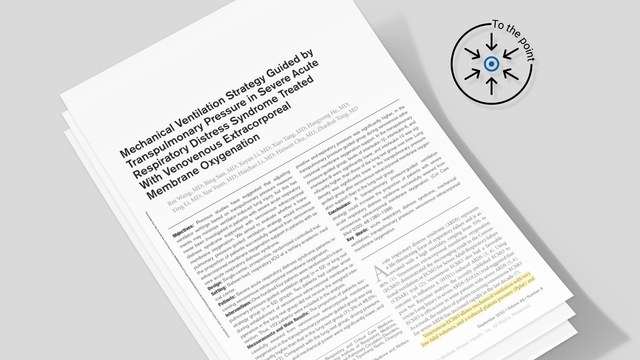
The authors' point? A Ptp-guided ventilation strategy resulted in a greater proportion of patients with severe ARDS successfully weaned from VV-ECMO when compared to a lung-rest strategy. Read on for more!

Would a ventilation strategy guided by transpulmonary pressure (Ptp) increase the proportion of patients successfully weaned from extracorporeal membrane oxygenation (ECMO) support when compared to the lung-rest strategy (LRS) recommended by the Extracorporeal Life Support Organization (ELSO) guidelines for patients with severe ARDS?
Inclusion criteria | Exclusion criteria |
| Patients who met the diagnostic criteria of the Berlin definition for ARDS | Age less than 18-years old |
| Cause of ARDS was pneumonia | Patients had been on high pressure (Ppeak > 35 cmH2o), high FiO2 greater than 0.8 and ventilation for longer than 7 days |
| Had one of the following disease-severity criteria despite optimum mechanical ventilation: (Vt 6 ml/kg of PBW, PEEP ≥ 10 cmH2O, FiO2 ≥ 0.8 and use of various rescue therapies) | Patients already suffering Pulmonary barotrauma |
| PaO2/FiO2 ratio ≤ 80 | Had a contraindication to heparinization |
| Arterial blood pH < 7.2 | Had an irreversible neurologic injury |
| PaCO2 > 60 mmHg | Severe chronic lung disease with life expectancy less than 6 months |
| RR maximized to 35 | |
| Pplat ≤ 30 cmH2O | |
Ventilation strategy Ptp-guided group | Ventilation strategy lung-rest group |
| Pressure assist-control mode | Pressure assist-control mode |
| Inspiratory pressure was lowered to keep Ppeak < 25 cmH2O | Ppeak was 20 to 25 cmH2O |
| PEEP was set at such a level that expiratory Ptp stayed between 0 and 5 cmH2O | PEEP was 10 to 15 cmH2O |
| Respiratory rate was 10 breaths per minute | Respiratory rate was 10 breaths per minute |
| FiO2 was < 0.5 | FiO2 was < 0.5 |
Mortality at 60 days
The 60-day mortality rate in the Ptp-guided group was significantly lower than that of the lung rest group (32.6% vs 54%; p = 0.030).
Kaplan-Meier analysis indicated that the Ptp-guided group had a significantly higher 60-day survival rate (p = 0.037) compared to the lung rest group.
ECMO duration
Mortality at 6 months
A Ptp-guided ventilation strategy was able to increase the proportion of patients with severe ARDS successfully weaned from VV-ECMO when compared to LRS.
Follow the individual links below to access the relevant clinical resources from Hamilton Medical.